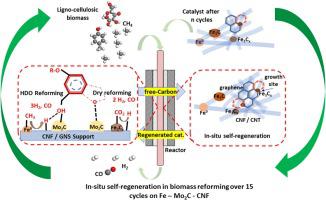Applied Catalysis B: Environment and Energy ( IF 22.1 ) Pub Date : 2020-09-23 , DOI: 10.1016/j.apcatb.2020.119537 Amoolya D. Lalsare , Brian Leonard , Brandon Robinson , Ali C. Sivri , Roman Vukmanovich , Cosmin Dumitrescu , William Rogers , Jianli Hu

|
In-situ self-regenerable Fe / Fe3C – Mo2C – CNF catalyst was developed and evaluated extensively over 15 cycles of CH4 – CO2 assisted biomass reforming. In-situ regeneration was observed through nucleation on carbon saturated Fe3Cx sites due to abundance of free-C from reaction and undercoordinated carbon in support. Molybdenum existed as stable β-Mo2C whereas Fe composition changed from Fe° sites to Fe3Cx. Due to highly dispersed small nanoclusters (< 5 nm) in lower Fe loading catalysts, graphene nanosheets (GNS) synthesis was observed whereas on 5 % Fe catalysts, large agglomerated nanoparticles (∼10 to 20 nm) facilitated CNF / CNT synthesis. Regeneration on 0.5 % Fe occurred through CNF growth while graphene cover regenerated 5 % Fe catalysts. Fe – Mo2C – CNF catalyzed reactions produce hydrogen rich syngas over 15 cycles with H2 concentration > 60 % and H2:CO ratio of 2–4. Hydrodeoxygenation reforming of biomass was typically between 40–60 % of the amount of oxygenates.
中文翻译:

自增碳纳米纤维负载的Fe-Mo 2 C催化剂,用于CH 4 -CO 2辅助生物质转化为富氢合成气
开发了原位自再生Fe / Fe 3 C – Mo 2 C – CNF催化剂,并在15个循环的CH 4 – CO 2辅助生物质重整中进行了广泛的评估。通过在碳饱和的Fe 3 C x位上成核观察到原位再生,这归因于反应中游离C的富集和载体中碳的配位不足。钼存在作为稳定的β-沫2 ç而铁组合物选自Fe°站点成Fe改变3 Ç X。由于在较低的Fe负载催化剂中高度分散的小纳米簇(<5 nm),观察到了石墨烯纳米片(GNS)的合成,而在5%Fe催化剂上,大的团聚纳米颗粒(〜10至20 nm)促进了CNF / CNT的合成。0.5%Fe的再生通过CNF的生长而发生,而石墨烯覆盖层再生了5%Fe的催化剂。Fe – Mo 2 C – CNF催化反应在15个循环中产生富氢合成气,其中H 2浓度> 60%,H 2:CO比为2-4。生物质的加氢脱氧重整通常占含氧量的40-60%。



























 京公网安备 11010802027423号
京公网安备 11010802027423号